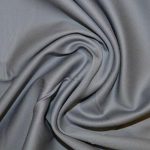Mould, mildew, fungus, yeast, and bacteria (microorganisms) are part and parcel of our everyday lives. Thousand of species of microorganisms are found in the environment, on our garments and on our bodies. Substances added to fibres, such as lubricants, antistatic agents, sizing agents, thickeners etc and dirt act as a source of food for microorganisms. The microbial growth is influenced by relative humidity and temperature. The microorganism’s growth on textiles causes a range of undesirable effects, not only on the textile itself but also on the user. These effects include stains and discoloration, generation of unpleasant odor, reduction in mechanical strength, and a risk of infection to user. The microbial growth on textiles, overall decreases functional, hygienic and aesthetic value of the textiles.

Microbial attack on textile is of great concern in textile worn next to skin, such as, apparels, socks, intimate wear, aprons, uniforms etc.; Home furnishing such as carpets, shower curtains, mattress ticking and upholstery as well as for industrial fabrics that are exposed to varied or harsh weather conditions such as filter fabrics, fabrics used for awnings, screens, tents, tarpaulins, ropes, etc. Mould and mildew are major cause of damage to outdoor textile. Many antimicrobial technologies viz. Silver, Silane, Chitosan etc are available for textiles. Out of these Zinc pyrithione based product act specifically against Fungi.
Zinc pyrithione was first developed in the 1930s for its antifungal and antibacterial properties, and it is still commonly used today as a main ingredient in anti-dandruff shampoos, and as an over-the-counter treatment for seborrheic dermatitis, psoriasis, eczema, athletes’ foot, ringworm and other medical conditions. Zinc pyrithione is also used in paints, polymers and textile products to inhibit the growth of fungi as well as bacteria on susceptible surfaces.
Zinc pyrithione mediated growth inhibition is due to increased copper uptake. Zinc pyrithione in presence of copper forms copper pyrithione which is exogenous (outside microbial cell). This copper pyrithione is then transported inside cell (endogenous) which eventually targets Iron-Sulphur(Fe-S) proteins in microbial cell. Fe-S proteins play key role in microbial metabolism. Deactivation of these Fe-S protein leads to stop in microbial metabolism eventually leading to cell death.(Fig.1)

Looking at demand’s of industry for antimicrobial finish exhibiting antifungal as well antibacterial finish for indoor as well as outdoor application such as Home textile, Sport textile and Technical textile etc, Sarex has developed antimicrobial finish Zoroguard-ZP based on Zinc pyrithione chemistry.
Unique features of ZnPT antimicrobial:
- No skin irritation
- FDA-approved microbicidal agent
- Passes test methods: AATCC 30 (antifungal test), AATCC 147 (Qualitative antibacterial test) AATCC 100 (Quantitative antibacterial test), JIS L 1902 (Antibacterial).
- Inhibits the odor generation; prevents the growth of mould/mildew.
- Effective against broad spectrum of microbes viz. Aspergillus niger, Escherichia coli, Staphylococcus auerus, MRSA and Klebsiella pneumoniae.
- Suitable for all types of substrate.
- Suitable for spray, exhaust and pad application.
- Leaching durable antimicrobial agent.
Recommended dosage:
Zoroguard-ZP : 10-30 g/l
Pick up: 65-70%
Bath pH : 5.0-5.0
Drying : 160oC, 2 min (for all substrate)
Results
AATCC-30 (Antifungal test method)

Figure 2 shows unfinished fabric covered with Aspergillus niger growth (on left), while zone of inhibition can be observed around Zoroguard-ZP finished fabric (on right)
AATCC-147 (Antibacterial test method)

In figure 3, Petri plate on Left hand side shows unfinished fabric showing no zone of inhibition awhile petri plate on right hand side shows fabric finished with 30g/l Zoroguard-ZP showing zone of inhibition against Staphylococcus aureus, Escherichia coli, Klebsiella pneumoniae and MRSA.
AATCC 100 (Quantitative antibacterial test)
Table below shows durable antibacterial activity of 30g/l Zoroguard-ZP finished fabric on different substartes.

Zoroguard-ZP exhibits antifungal activity against Aspergillus niger and antibacterial activity against Staphylococcus aureus, Eschericia coli, MRSA and Klebsiella pneumoniae.
